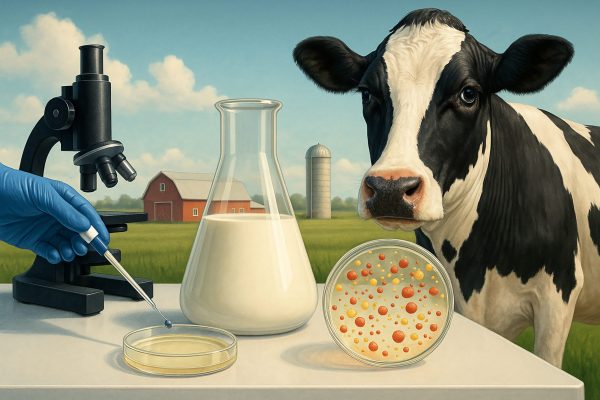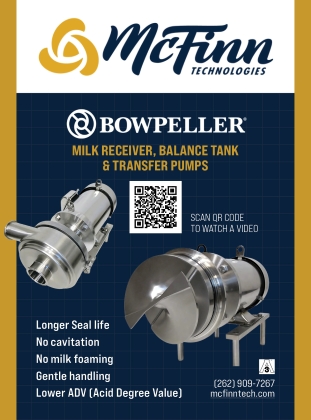Why SPC Matters in Today’s Dairy Operations

Why SPC Still Matters in Today’s Dairy Operations
Standard Plate Count: An Overall Process Control Parameter for Raw Milk Microbiological Quality
The level of bacteria in raw milk is a key quality parameter that provides an overall indication of on-farm hygiene and compliance with Pasteurized Milk Ordinance (PMO) regulations and cooperative or processor quality premium thresholds. It is also critical to quality because some types of bacteria in raw milk go on to impact the quality of milk and dairy products after pasteurization and processing.
SPC vs. IBC: Understanding the Numbers Behind Milk Quality
The reference method for measuring bacterial levels in raw milk is the standard plate count (SPC). This method involves plating a small volume of milk onto standard methods agar and incubating the plates at 90°F for two days and then counting how many individual bacterial colonies, or colony forming units (cfu), have grown.
While this method has been used for decades in the dairy industry, more rapid methods have been developed and validated as acceptable alternatives to the SPC method, including flow cytometry methods like the FOSS BactoScan™ that don’t require an incubation period. In flow cytometry methods, a very thin column of sample is passed by a laser that counts individual bacterial cells resulting in an individual bacteria count (IBC). The IBC is ultimately converted into SPC using a mathematical formula, because unlike SPC, which only selects for bacteria that can grow under the conditions of the test, flow cytometry counts all bacterial cells.
Don’t Just Meet the Limit—Aim for Excellence
The PMO requires that SPC not exceed 100,000 cfu/mL in raw milk from an individual producer, but the threshold for quality is far below the regulatory limit. Most contemporary bulk tank raw milk should not exceed 10,000 cfu/mL. However, high quality raw milk should consistently remain below 5,000 cfu/mL. It’s important to not only pay attention to the absolute SPC value, but also to how much it fluctuates over time as this can also be an indicator that practices are not well controlled.
What Causes High SPC? A Look at the Common Culprits
High SPC is often due to a combination of i) the source of the bacteria, ii) the type of bacteria, and iii) if the bacteria have been exposed to conditions that allow for their growth. Understanding each of these factors is important to keeping SPC low and for troubleshooting when SPC is high.
Mastitis-Related Bacteria: Silent Drivers of High Counts
Milk from clean, healthy cows contains very low levels of bacteria. However, cows with mastitis may considerably impact the SPC of the bulk tank, depending on the proportion of the herd affected and the level of bacterial shedding that occurs during milking. In particular, Streptococcus agalactiae and S. uberis can cause spikes in bulk tank SPC due to the high level of shedding during milking.
The Dirty Truth About Environmental Contaminants
In addition to bacterial contamination from mastitic cows, the environment itself is an important source of bacteria. Bacteria are widespread and abundant in the dairy farm environment and in materials like manure, bedding, and soil. Even small amounts of residual material introduced during milking can quickly increase bulk tank SPC above quality thresholds due to the extremely high levels of bacteria in these materials. For example, manure contains millions or even billions of bacteria in just a single gram.
Biofilms in Equipment: The Hidden Reservoir
Another important source of bacterial contamination in raw milk is improperly cleaned and sanitized equipment. Many bacterial types can form structures called biofilms in equipment; these communities of bacteria produce a sticky substance that envelops and protects them from cleaning and sanitation. During milking, some of the bacteria in the biofilm then break off and contaminate the milk.
Cold Doesn’t Always Mean Clean: Psychrophilic Bacteria Explained
Once bacteria find their way into milk, many will continue to grow and multiply. The extent of this growth depends on the type of bacteria, the temperature of the milk, and how long the milk is held. Some types of bacteria, called psychrophiles (psychro = cold, philes = loving) like Pseudomonas, grow relatively quickly at temperatures below 45°F, and even 40°F, leading to substantial increases in the overall number of bacteria. Other relevant bacteria, like coliforms, can be psychrotolerant, meaning they don’t prefer cold temperatures, but they can grow at cold temperatures if given enough time.
Other groups of bacteria, for example, most mastitis causing bacteria, do not grow at low temperatures and therefore, even if they are present, they will not increase in number during cold storage. It’s important to note that temperature and storage conditions are the most likely cause of very high SPC exceeding the PMO limit of 100,000 cfu/mL.
Troubleshooting High SPC, Your Dairy checklist
If you’re struggling with high, or inconsistent SPC, systematically reviewing these factors will help to determine the root cause:
- Is your milking preparation procedure adequate and are all parlor employees following the procedures consistently across all shifts?
- Observing the milk filter after each shift can be an easy indicator of how much residual material is being introduced during milking.
- If there is an associated increase in bulk tank somatic cell count, this may be an indication that mastitis organisms are playing a role in the bulk tank SPC.
- Visually inspect equipment, including rubber goods, for locations that may not be cleaned well.
- Verify that cleaning and sanitation chemicals are being dispensed in appropriate concentrations.
- Check water quality metrics, like hardness, and ensure that water temperature is high enough. Recommended minimal temperature is 165°F.
- Inspect temperature charts. Are there large deviations or has the milk been held above 40°F for longer than 24 hours?
It may be necessary to sample from different locations in the milking system to narrow down the origins of the bacterial contamination. Other differential bacterial tests, like coliform count, laboratory pasteurization count, etc., may also be used to support the investigation.
Consistent Quality Takes a Farm-Wide Commitment
Ultimately, keeping SPC consistently low requires a systematic approach that includes udder health, sampling and testing, equipment cleaning, and parlor best practices for raw milk handling.
Precision Sampling to Pinpoint Contamination Sources
Consistently low SPC begins with accurate, representative sampling. QualiTru Sampling Systems provides dairy producers with a trusted, aseptic method for collecting samples throughout the milking process—from the parlor to the bulk tank. By enabling strategic sampling at multiple points, QualiTru helps identify the origin of microbial contamination and supports data-driven troubleshooting. Whether monitoring udder health, evaluating equipment sanitation, or verifying milk cooling efficiency, QualiTru’s sampling systems make it easier to isolate variables and maintain high-quality milk standards across the farm. Learn more at www.qualitru.com.
For more Cattle Industry News – Home – American Cattlemen
For Outdoor Enthusiasts – The Iowa Sportsman is the place to be!



